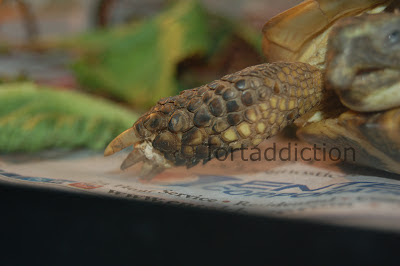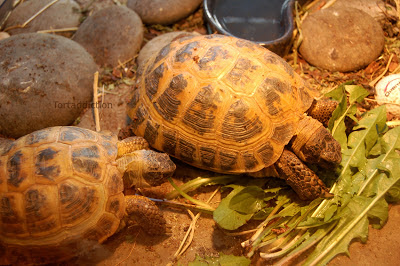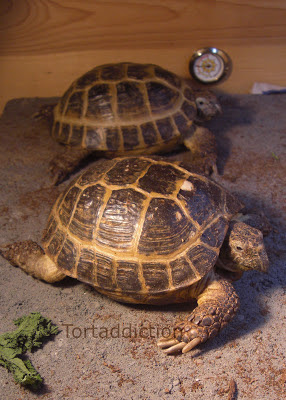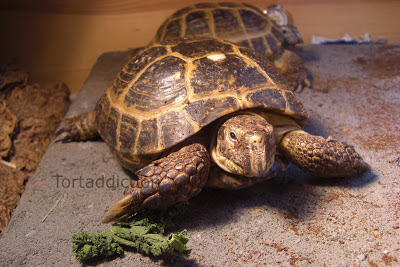Telling Norbert's rescue and rehabilitation story makes me sad and happy at the same time. Little Norbert the Russian tortoise (Testudo horsfieldii) came to us early this Summer. He was a terribly malnourished, weak, skinny, mangled little tort, and over the course of several months, I nursed him back to health. Sometimes it was touch-and-go (we didn't name him for the first month, because we were afraid he'd die!), but he survived, and is thriving now!
.JPG) |
| I took this pic after I gave him his first bath. He was too weak to open his eyes. |
Before telling Norbert's story, I would like to thank a few people. It was SO nice to know that there were folks far and near cheering little Norbert on as he got better! I couldn't have done this by myself!
- First, I'd like to thank Mary Esther from the
International Reptile Rescue in Canby, OR. Her advice, hands-on expertise, and encouragement helped me immeasurably throughout Norbert's rehabilitation. Mary Esther has a huge heart for reptiles, and has some pretty amazing (and some tragic) rescue stories to tell from her 30+ years of experience. I am honored to know her, and to count her among my friends.
- Second, I'd like to thank Joe H. and Robbie (and all others who chimed in) from the
Turtle and Tortoise Forum for their advice, empathy, and encouragement. You guys have no idea how much you helped!
- Last, but certainly not least, I want to thank my wonderful husband for encouraging, supporting, and comforting me throughout all the ups and downs of this journey!
Now, Norbert (aka Stumpy)'s story:
A friend of an acquaintance was looking for someone to take in the tortoise that their 16-year-old son had gotten bored of. It sounded fun, so I said "yes" - having NO idea what I was getting myself into.
The little tort was brought to me in a cardboard box filled with straw. He was small, VERY skinny, and so crusted over in dirt that I couldn't tell what color his shell was. He also had a horrible, decaying smell about him. I was too shocked to say anything (anyone who knows me can attest that this does not often happen) to the boy's Dad. I was also too shocked to take a picture of the little tort while he was still covered in dirt.
 |
| Left: Timmy's healthy leg. Right: Norbert's skinny leg |
As it turned out (once I found my voice again, and was able to ask), the tortoise had spent 2 years living in a barn stall, without heat or lighting. The boy whose tortoise this was had lost interest, and didn't feed or water it for 6 months! I could tell by the look in the Dad's eyes that he was ashamed, and he said that he had no idea that it had gotten this bad until he picked the tortoise up to bring him to me.
As soon as we were home, I ran a warm soaking bath for the little tort. He was so weak that he couldn't lift his head, so I placed a small flat rock into the bath so he wouldn't drown. After a few minutes of relaxing in the warm water, he began to drink. And drink. And drink. As he warmed up, his smell became worse. I kid you not, he smelled like dead animal. I gently scrubbed away the dirt on his shell with a toothbrush. His shell was a sickly pale green color, and had what looked like bite marks from a dog in 4 or 5 places. Surprisingly, the shell felt good and hard, and his plastron was in perfect condition. His skin was pasty and almost transparent. He was so thin I could see his bones, and his face was sunken. His beak was overgrown, and his eyes were swollen shut. Amazingly, his nose was dry, and he wasn't wheezing.
 |
| Freshly bathed, and warmed up a little |
I changed the dirty water, and placed the little tort into clean warm water to soak a little longer. I let him soak for another 20 or so minutes, staying close by to make sure his head didn't slip into the water. All of a sudden, ONE OF HIS TOES came off and floated away! I lifted him out and gently placed him on a towel to examine him. Sure enough, one toe on one of his front feet had withered and fallen off, thankfully without leaving an open wound. After further examination, I discovered the source of the horrible smell: 3 of the toes on his other foot were half-severed and the flesh was festering and smelled horrible. I wrapped the little tort into the towel and carefully soaked the hurt leg in some salt water to disinfect it. Then I smeared some neosporin on it (I had to work with what I had on hand for now, since I had not been expecting such a sick tort!).
 |
| Here you can see the 3 dead, rotting toes (the top one is still healthy) |
Next I weighed and measured the little tort. He was 5.5 inches (14cm) long (shell length) and weighed only 275g! My little Roz is that size, and he weighs more than 500g! (The sick tort had a Jackson's ratio of 0.10 - a tort with a ratio under 0.16 is undernourished!)
I pilfered a heat lamp from my two healthy tortoises, and gently placed the little tort on some newspaper inside a 10 gallon aquarium - not an ideal enclosure for a tortoise, but ok as a "hospital" tank. I put in a large handful of dandelion leaves in front of the poor tort, not sure if he'd have the strength to eat. I made a little hide house out of a shoe box. Slowly, VERY slowly the tortoise opened his mouth and chomped on a leaf. His beak was so overgrown that he had a bit of trouble taking a good bite, but he managed to wolf down one leaf. Then he rested, and a few minutes later, ate another. I let him eat for about an hour (since he was eating so slowly), then removed the rest of the leaves, since I didn't want him to make himself sick by over-eating.
 |
| Still too weak to lift his head or open his eyes... but OH did those dandelions taste GOOD! |
The next morning I met with Mary Esther from the
International Reptile Rescue (IRR). She examined the little tort, and decided to hold off on trimming its beak. The most important thing right now was to make sure he was eating, and she didn't want him to be sore from a trim. She advised me to continue daily soaks to help re-hydrate the tort, and to aid his filter organs in expelling the toxins that built up over the months of not eating or drinking. She looked at his mangled toes, and decided it would be best to continue disinfecting them, and to let nature take its course, rather than amputating. She said they would most likely fall off on their own, and the stump would heal, as long as the infection was kept at bay. She also lent me some extra supplies to ensure the tort stayed warm. She also recommended that I paint some diluted betadine all over his shell, because the tort had some shell rot, and also had some weird cracks where the scutes were coming apart a bit (most likely from dehydration and malnutrition, possibly from being bitten by a dog).
 |
| Here are the cracks he had between his scutes |
For the first few days, the little tort was so weak he didn't move from the spot, and didn't pull his legs into his shell. He just sprawled in his warm tank, napped, ate, slept, and of course soaked in the warm baths I gave him. Every time he was in the water, he drank like a camel. About 5 days after getting him, he started expelling enormous amounts of urates. This was good - it meant that his kidneys were functioning. He still barely moved, but he ate, and his eyes began to open. He began to become responsive to his surroundings - he seemed to enjoy having his head stroked, and he would turn his head to watch me walk by his tank. He eagerly ate leaves out of my hands, too. About 10 days later, he started sleeping with his legs pulled into his shell - he was strong enough to start protecting himself!
 |
| Eating again - several days later. His shell is still painted with betadine |
His foot wound stopped stinking after a few days of soaking and antibiotic ointment. After a few weeks, the little tort started cautiously moving around his tank, still too weak to lift his shell off the ground. His little legs and neck were still scrawny, but I could no longer see every bone. Very slowly I had begun introducing some UVB by taking him outside into the garden for 10 minutes at a time. He hadn't been in contact with UV light for nearly 2 years, so we didn't want to stress his system, or cause too fast growth, which would cause a whole new host of problems. Bit by bit I increased the time I let him outside, and I discovered that he was absolutely WILD about eating clover flowers. He could strip a whole patch of clover flowers in the course of about 15 minutes. I began to shine a UVB bulb on his tank for a few hours every day, and his coloring started to improve. His shell started turning to a very pretty golden hue, and his pale little legs began to turn brown.
 |
| ...starting to explore just a little while sun bathing |
One night he started pacing in his little tank - I could hear him digging and clonking, and was SO happy that he was beginning to act like a tortoise: he was rearranging his furniture. All this commotion also caused him to lose his 3 withered toes, leaving behind a handsome little pink stump with 1 toe left. There was no more infection, and he walked on it without any sign of discomfort. That morning we named him Stumpy. We finally were fairly sure that he would pull through. He was still very skinny, but he was slowly and steadily packing on weight, and he was acting more and more like a normal tortoise.
 |
| The brand new stump - no more rotting toes! New pink skin! |
Now that little Stumpy was less scrawny, we were fairly sure that he was a male. Because of this, I knew I wouldn't be able to keep him, since I already have a male and a female Russian tortoise. I did not feel comfortable just letting "somebody" (e.g. from Craigslist) have him, so I was delighted when my friend "dibbsed" Stumpy for her sister Rachel. He still needed to stay with us for a little while, but it was such a relief to know he would have a family that was knowledgeable and would spoil him rotten once he was ready.
 |
| (yum! Clover flowers!) You're looking so good, little guy! |
At this point Stumpy still had his overgrown beak, and rather than have it trimmed, I decided to try a little trick I had heard about: I picked an unripe apple, and offered it to him hole, with just a small chunk cut out so he could smell it. About 2 hours later, the apple had a few tiny bits pried out of it, and Stumpy had gotten the overhanging beak piece stuck in the apple and had shed it.
 |
| Shedding the overgrown beak piece left those 3 funny little tips. |
The final couple of months were pretty smooth sailing: Stumpy kept on gaining weight, he became more and more curious, and stronger, and more active. He was a spunky little fella!
 |
| Stumpy exploring the little path that goes through our rock garden. I had just hosed him down. Doesn't his shell color look amazing?! |
Finally the day came for my friend's sister to pick him up. She had built him a nice big tortoise table that had everything he needed. With a heavy but happy heart, I sent him on his way, and so, 'Stumpy' became 'Norbert.'
 |
| That's right. I tied a big bow around Norbert when Rachel came to get him! |
Now he happily lives with Rachel, where he dines like a little prince, gets cuddled and stroked, bathed and kissed. He went from almost dying of hunger to being one of the happiest, luckiest, most loved little torts in the country! That's what I call a happy ending...
 |
| Life is good when you have a full belly and a warm home! |






















.JPG)

























